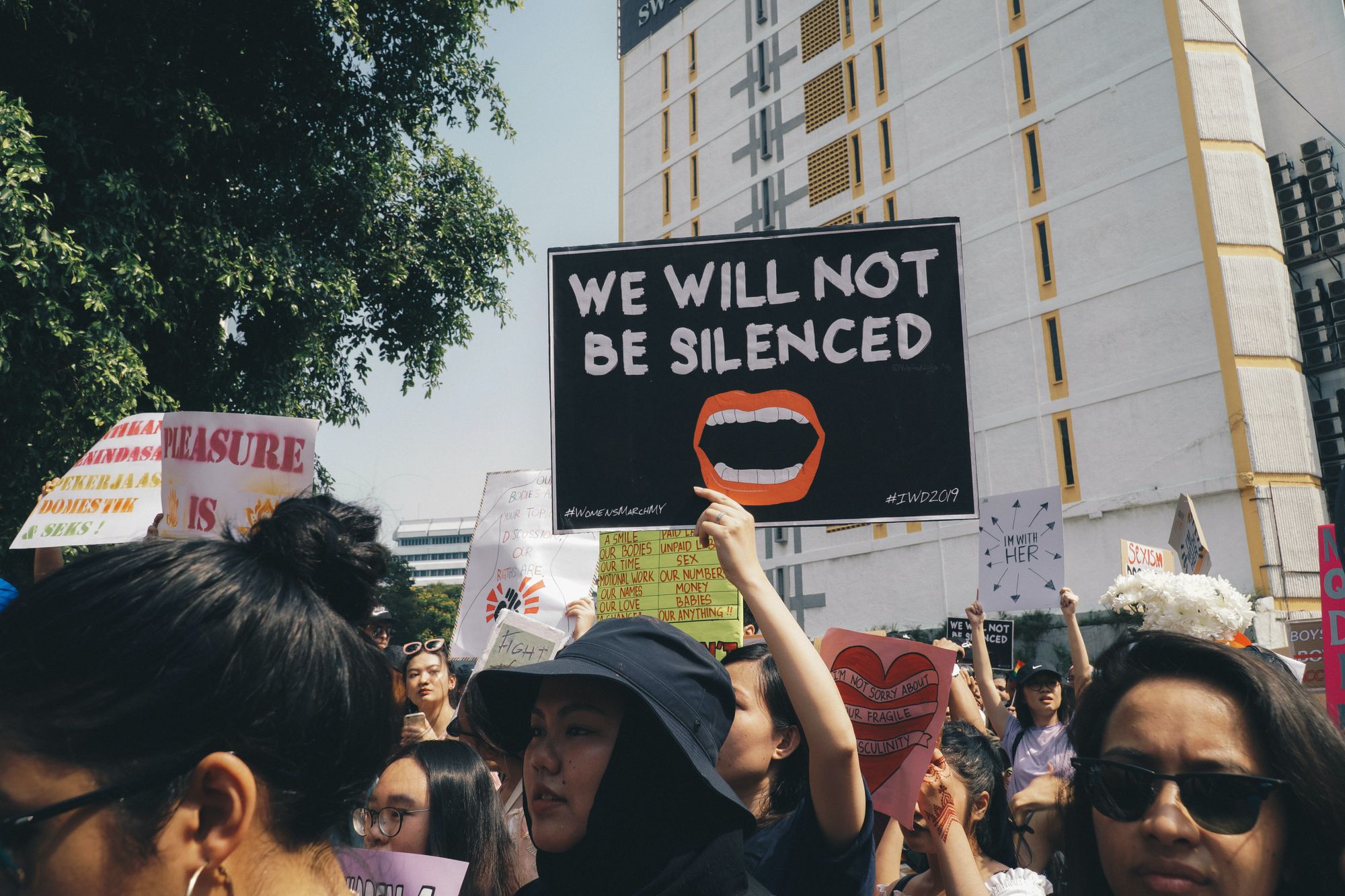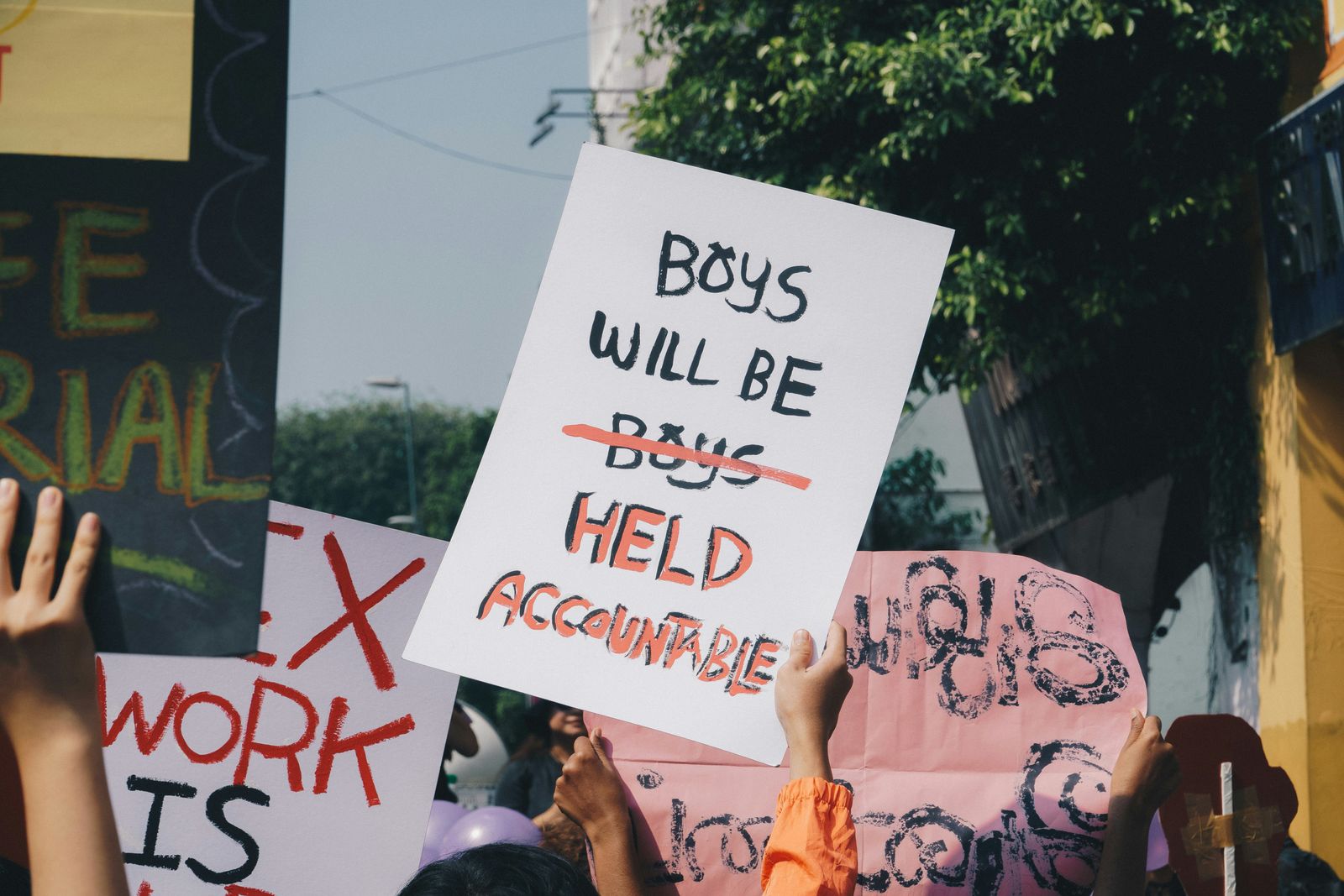Weaponized words are used to fix femininity into a narrative of fragility. In normative explanations of gender and expression, feminine expression is characterized as emotional, needy, and codependent. These are attributes that affirm fragility. In contrast, strength, toughness, dependability, and leadership are viewed as masculine. Because of this dichotomy, feminine fragility is reaffirmed every time a man is affirmed of his masculine superiority. Publicly endorsed standards of femininity are particularly prevalent within discussions of sexual harassment: a broad term used to refer to unwelcomed sexual advances, requests for sexual favors, and other sexualized verbal or physical conduct. Further, the social construction of feminine fragility is used to reinforce an image of sexual fragility, contributing to women’s objectification. Objectification contributes to broader patterns of discrimination, power, and male privilege, while also sustaining gender inequalities that increase the risk of sexual violence among women.
Social forces—relationships, beliefs, and values—tether femininity to harmful stereotypes and contribute to unequal power relations between women and men. In a patriarchal society, the ideal woman is associated with powerlessness. Thus, when a woman earns a position of power, she breaks out of character and steps away from the narrative. Sexual harassment is then used to obstruct the woman’s power, further entrenching her into control and domination. When women endure sexually traumatic experiences, society repackages patriarchy yet again, labeling the survivors as damaged goods. In tandem with other diverse elements, these particular rhetorics have deterred women from publicly opening up and expressing discomfort in these social constructs. To address these circumstances, the #MeToo movement was conceived. The underlying message was to counter prominent social expectations and change the narrative of acceptable female expression. Globally, women released personal statements on sexual harassment and violence at protests, on social media, and throughout the news. They sought to increase awareness, change societal perspectives, hold perpetrators accountable, and eventually prevent sexual violence writ large.

The Origins of the #MeToo Movement
To stand up against perpetrators of sexual violence, activist Tarana Burke, a survivor of sexual assault, coined the term “me too” in 2006. Burke initially focused on women of color, using the term to emphasize empowerment through empathy. On October 5, 2017, actress Alyssa Milano exposed film producer Harvey Weinstein in a New York Times article. A week later, Milano tweeted the phrase “Me too,” encouraging survivors to speak up. With the Weinstein sexual abuse scandal continuing to unfold, the phrase attached quickly to posts that flooded social media platforms. American Olympian McKayla Maroney joined in, tweeting to expose Team USA’s gymnastics doctor Lawrence G. Nassar: a convicted rapist and sexual assaulter. One after another, hundreds more allegations surfaced, challenging power dynamics with demands for legal action against perpetrators.
The Nature of the Shared Stories
By 2018, Facebook revealed that 45 percent of users in the United States had friends who took part in storytelling: the sharing of posts regarding past personal experiences. The majority of them were women. With reports showing that women are more likely to experience sexual harassment than men, such a distinction is not unexpected. According to the United Nations, more than one in three women worldwide have experienced sexual harassment. Another national study found that the percentage could be as high as 81 percent of women who experienced sexual harassment during their lifetime.
From some women declaring the end of their silence to others confirming that they are not alone, millions of tweets flooded social media feeds within the first six months of #MeToo. The movement mobilized rapidly as it went viral in over 85 nations. Several of the posts vividly exposed the magnitude of sexual violence with gut-wrenching details. According to a study on demographic representation and storytelling during the first year of the movement, Black women in particular tweeted about emotional support, criticism of governmental agencies, and concerns regarding discriminatory practices. Most commonly, women expressed both the need to share their past traumatic experiences and validate others who had similar experiences.
Story Sharing from the Perspective of Women Identifying Survivors
Many women—including survivors—expressed feelings of empowerment from participating in the movement. One of them is Haley Jakobson, an author who writes on queerness, trauma, and mental health. On CBS Mornings, Jakobson vocalized her past, sharing that she was taken advantage of and raped. She went on to mention that sharing her experience felt empowering as a rape survivor, emphasizing that it was her “truth and no one can take that away” from her. Another woman shared on Twitter, “#MeToo And I was blamed for it. I was told not to talk about it. I was told that it wasn’t that bad. I was told to get over it”. To support her vocalization, another woman responded “You get better & stronger so you can fight more courageously! #meToo”. Messages such as these provide a context for the effect #MeToo had, as well as its goals: reclaiming power and redefining femininity.
Others also described the emotional toll of opening up. With trolls mocking their messages and skeptics discrediting their experiences, they felt that invalidation was far too prevalent. Visible to the public in comment sections and posts, these harmful contributions hindered the momentum of the movement. In addition, women of color expressed how the movement contributed to feelings of exclusion and devaluation. The overrepresentation of white women in #MeToo posts—a stark contrast to the underrepresentation of women of color—further illustrated the disproportionality. This exposed how Burke’s initial intent to center on women of color lacked priority as the movement progressed. In response, the movement has redirected initiatives towards the inclusivity of marginalized survivors: youth, queer, trans, disabled, and people of color.
The Impact of the #MeToo Movement: An International Angle
While survivors worldwide attempted to reconstruct femininity through storytelling, the magnitude of change remains undefined. Intrinsically, the movement’s aftermath is not homogeneous. In 2018, even Washington state Senator Karen Keiser—an advocate for the prevention of sexual harassment in the workplace—expressed her uncertainty about the movement leading to actual change. In addition, the impact of the global movement remained centralized in the United States as other countries experienced less rapid progress.
In Italy, responses to survivors were particularly alarming. In 2017, one judge ruled against the survivor, declaring the survivor as “too masculine” to be a victim of sexual violence. The trend of delivering such insensitive, invalidating responses continued into 2023 when another judge justified the groping of a teenage girl on the basis that the sexual harassment lasted “less than 10 seconds.” Another instance of devaluing women and their traumatic experiences appeared once again when two sexual violence cases publically surfaced. The Guardian spotlighted the legal consequences of normalized downplaying and victim-blaming towards female survivors, revealing deep-rooted sexism and subjugation of women.
Throughout China, the spread of the movement, especially with public accusations against screenwriter Shi Hang and talk-show host Zhu Jun, led to extensive efforts to redefine the term “sexual harassment.” CNN also reports on how these efforts were initially challenged by verbal attacks and censorship; however, a few legal revisions were attained as a crackdown on the entertainment industry proceeded. Following increasing demands for accountability, local authorities also attempted to implement anti-harassment regulations, including a more robust initiative (effective since January 1, 2023) to prevent sexual harassment of women in the workforce. However, regulatory enforcement continues to fall short due to a lack of delineation, guidelines, and compliance. The issue may stem from the Chinese government neglecting to hold sexual harassment as a legal offense prior to 2021 while simultaneously pushing forward de-genderization efforts that reduced focus on the protection of women who are those most affected.
Across South Asia, the social taboo surrounding discussions of sexual experiences, harassment, and other forms of violence is a constant barrier to the storytelling process. Legal punishment and social ostracization of perpetrators are proven methods to prevent further acts of violence; however, enforcement mechanisms are nearly effective or timely. Although Article Fifteen of the Indian Constitution legally prevents discrimination and other treats to equality, sexual harassment in the work place remains on the rise. Based on annual reports from companies in India, a twenty-seven percent increase in complaints was found from 2021 to 2022. Moreover, a large majority of garment workers in Bangladesh have experienced sexual harassment in the workplace. Similar issues are prevalent in Nepal and Pakistan. While the movement does spotlight this status quo and create a space for activism, a concrete solution remains unknown.
Further, due to rigid differences in cultural and societal norms, the #MeToo movement seems to work through revision rather than reform. Specifically with purity culture persisting generationally and globally, it actively restricts productive, meaningful conversations about sexual health and autonomy in South Asian communities. Guilt and shame perpetuated by purity culture are also internalized by survivors, who feel a sense of failure to meet the sexist standards of purity and lack the recognition of the harm inflicted on them. Legal consequences also become implicated as laws face significant implementation hurdles, including a lack of social support and accountability. Thus, in many South Asian countries (e.g. India and Bangladesh), the pace of progress—although noted in relation to the rise of the #MeToo movement—is slow.
Contrastingly, the impact of #MeToo in the United States was prominent. Several studies support lasting shifts in societal response. Legal ramifications after the Weinstein scandal disclose that a significant portion of society has collectively influenced political action. For instance, state legislatures were under growing pressure to curb sexual assault and harassment. Many states directed efforts towards ending the backlog of rape kits, such as providing financial support for testing and approving new procedures for timely testing. In addition, funds were raised for the legal fight against harassment, including the US$ 22 million Time’s Up Legal Defense Fund. The fund helped over 3,600 low-income women gain access to attorney consultations and pay legal fees. Resource hotlines also indicated surges aligning with the time of publication of major #MeToo movement posts. Overall, through the enactment of newly introduced legislation and initiatives regarding sexual violence prevention, tangible changes were made.
The Future of Femininity in the Context of Sexual Harassment
For those who could connect and find support, story-sharing throughout the #MeToo movement gave access to healing, empowerment, and solidarity. In the United States, discussions on sexual harassment and related retaliation increased by over thirteen percent since 2017. Seventy-four percent of women also expressed a greater willingness to speak up against harassment. As Women’s March Co-Chair Carmen Perez confirms, the movement is about survivors “reclaiming our power”. On that account, many survivors were able to gain a sense of community: one that validated their trauma and removed perpetrators from positions of power. However, the movement is far from over.
According to the Work Bank, there are 50 countries that have not implemented legislation centered around the sexual harassment of women. Evidently, this reveals a need for an all-encompassing global legislation that targets the prevention of sexual harassment and other forms of violence against women. Improvement must continue, and acknowledging those opportunities does not distract from the progress made. Rather, this should direct collective efforts toward disrupting existing systems that maintain unequal social relations.





